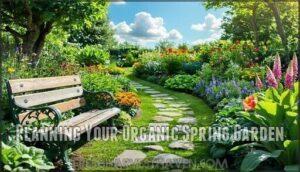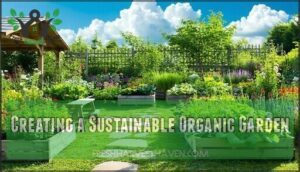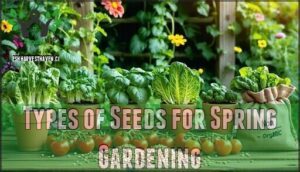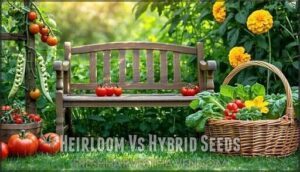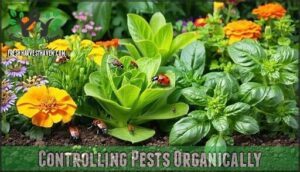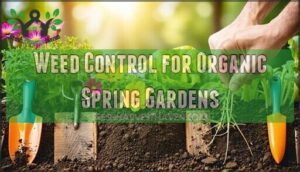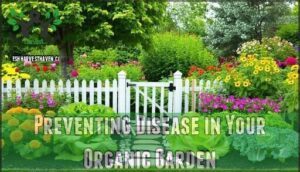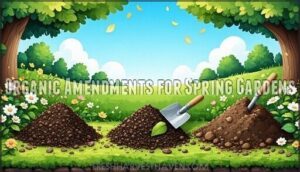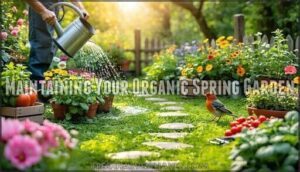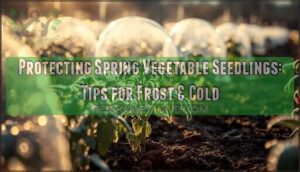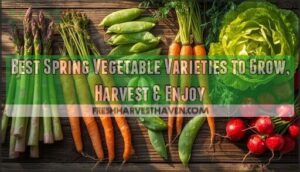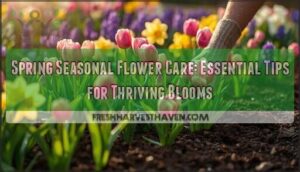This site is supported by our readers. We may earn a commission, at no cost to you, if you purchase through links.

You’ll start by timing plantings with frost dates—cool-season crops like lettuce handle light frosts, while tomatoes wait for warmer soil.
Build healthy soil biology through compost and natural amendments instead of synthetic fertilizers.
Use companion planting to naturally suppress pests and attract beneficial insects.
Test your soil temperature (50-70°F for germination) and choose your garden’s location based on six hours of daily sunlight and proper drainage.
The secret lies in working with seasonal rhythms rather than fighting them, creating an ecosystem that thrives on its own momentum once established, using natural amendments and healthy soil biology to support chemical-free gardens.
Table Of Contents
- Key Takeaways
- Planning Your Organic Spring Garden
- Creating a Sustainable Organic Garden
- Choosing The Right Organic Seeds
- Planting Your Organic Spring Garden
- Watering and Irrigation for Organic Gardens
- Controlling Pests Organically
- Weed Control for Organic Spring Gardens
- Preventing Disease in Your Organic Garden
- Organic Amendments for Spring Gardens
- Maintaining Your Organic Spring Garden
- Frequently Asked Questions (FAQs)
- What is the 3-hour gardening rule?
- What is the 3 year rule in gardening?
- Is Miracle-Gro ok for organic gardening?
- Why should you start an organic spring vegetable garden?
- How do you make a good organic garden?
- How do I start organic gardening?
- What is included in the introduction to organic gardening?
- How do you care for an organic garden?
- What is the gardening 3 year rule?
- What is a disadvantage of organic gardening?
- Conclusion
Key Takeaways
- Time your plantings with soil temperature – You’ll need 50-70°F soil for germination, not just air temperature, and should plant cool-season crops before warm-season ones based on your frost dates.
- Build healthy soil biology through compost and natural amendments – You’ll create self-sustaining ecosystems by feeding beneficial microorganisms instead of relying on synthetic fertilizers that disrupt soil health.
- Use companion planting for natural pest control – You’ll attract beneficial insects and suppress pests naturally by pairing plants like basil with tomatoes or marigolds with vegetables.
- Work with seasonal rhythms rather than fighting them – You’ll achieve better results by understanding your growing zone, microclimates, and natural cycles instead of forcing plants to grow in unsuitable conditions.
Planning Your Organic Spring Garden
Planning your organic spring garden requires careful consideration of location, climate, and soil conditions.
You’ll need to evaluate sunlight exposure, drainage patterns, and growing zones to create ideal growing conditions for your plants, considering factors such as complete concepts to ensure the best results.
Choosing The Right Location
Since successful garden location determines your entire growing season’s outcome, you’ll need proper soil assessment and sun exposure evaluation first.
Choose spots receiving six hours of daily sunlight with adequate water access and good drainage.
Consider your microclimate’s wind patterns and frost pockets during garden planning.
Essential location factors:
- Sun exposure – minimum six hours daily direct sunlight
- Soil preparation – well-draining soil with proper pH levels
- Water access – convenient irrigation for consistent moisture
- Garden design – accessible layout for maintenance tasks
Determining Your Growing Zone
Finding your growing zone reveals successful spring gardening timing.
The USDA Plant Hardiness Zone Map reveals your area’s average winter temperatures and frost dates, essential for garden planning.
Your growing zone determines which plants survive your climate conditions and when to start planting.
This knowledge guides garden zones selection and prevents frost damage to tender seedlings.
Assessing Microclimates
Your yard contains hidden microclimates that directly impact plant survival and growth rates. After identifying your growing zone, map these variations to optimize plant placement and maximize harvest yields.
- Sun Exposure: Track sunlight patterns hourly to identify full-sun, partial-shade, and deep-shade garden zones for proper crop selection.
- Wind Patterns: Document prevailing winds and create windbreaks using natural barriers to protect delicate seedlings from desiccation.
- Frost Pockets: Locate low-lying areas where cold air settles, avoiding these zones for frost-sensitive plants during early spring.
- Soil Temperature: Monitor temperature variations across your property, as south-facing slopes warm faster than north-facing areas.
Selecting The Best Garden Beds
Garden beds form the foundation of your organic spring success. Choose bed materials like untreated cedar, stone, or galvanized steel for durability. Size considerations matter—keep beds 4 feet wide maximum for easy reach.
| Garden Bed Type | Best For |
|---|---|
| Raised Bed Gardening | Poor drainage, heavy clay soil |
| Inground | Good existing soil, budget constraints |
| Perennial Landscaping Beds | Long-term plantings, low maintenance |
| Container Gardens | Limited space, renters |
| Hybrid Systems | Maximum flexibility, varied crops |
Drainage solutions include adding gravel layers or selecting elevated designs. Budget options range from DIY wooden frames to repurposed materials. Aesthetic choices enhance your garden’s appeal while maintaining function.
When choosing your garden beds, prioritize accessibility and soil health over appearance alone.
Preparing The Soil for Spring
Three key steps release your soil’s potential for spring success. Soil testing reveals pH levels and nutrient deficiencies that need attention. Compost addition and organic matter create the foundation for healthy plant growth.
Here’s your soil preparation roadmap:
- Test soil health using a simple pH kit to identify pH balancing needs
- Mix composting techniques materials like aged manure into existing earth
- Apply natural fertilizers such as bone meal for targeted nutrition
- Spread mulch benefits using organic materials for moisture retention
Proper amendments transform average dirt into thriving garden gold.
Creating a Sustainable Organic Garden
Building your sustainable organic garden requires choosing the right foundation method for your specific space and soil conditions.
You’ll need to decide between breaking ground for an in-ground garden, constructing raised beds for better drainage and soil control, or combining both approaches to maximize your growing potential.
Methods for Breaking Ground
Breaking new ground requires smart site clearance and soil testing before choosing your approach.
Lasagna gardening layers cardboard and organic materials to smother weeds naturally, while the lazy way tarping smothers grass over months.
The quick way mow mulch cuts vegetation short before covering with mulch.
Skip rototilling – it disrupts soil structure and beneficial microorganisms that healthy plants need.
By adopting no till methods, gardeners can preserve soil health and promote a thriving ecosystem.
Building Raised Beds
Raised beds transform your garden into a controlled growing environment that maximizes plant health and minimizes maintenance. These elevated structures offer superior drainage system benefits while reducing soil compaction around your crops.
Raised beds give you total control over your growing environment while cutting maintenance time in half.
Organic gardening transforms your backyard into a thriving ecosystem without synthetic shortcuts
Here’s your essential setup process:
- Select untreated cedar or composite materials for your wood selection and bed frame construction
- Install bed liners to prevent soil migration while maintaining proper drainage
- Fill with quality soil mix ensuring 8-12 inches of soil depth for root development
Position your raised beds in areas receiving six hours of daily sunlight. The elevated design provides better soil preparation control compared to inground gardening, allowing you to create ideal growing conditions.
Proper garden bed preparation includes adding compost layers and applying mulching around bed perimeters for moisture retention.
Starting an In-Ground Garden
Creating an in-ground garden starts with soil testing to check pH levels and nutrient content.
Design your garden layout considering sun exposure patterns throughout the day.
Begin bed preparation by removing grass and weeds, then add soil amendments like compost to improve structure.
This soil preparation creates the foundation for successful in-ground planting using proven organic gardening methods and spring gardening tips.
Choosing The Right Organic Seeds
Selecting the right organic seeds forms the foundation of your spring garden’s success, determining everything from germination rates to harvest quality.
You’ll need to evaluate seed types, genetic heritage, and climate compatibility so that your plants thrive in your specific growing conditions.
Types of Seeds for Spring Gardening
Selecting quality organic seeds gives you complete control over your garden’s foundation.
Choose certified organic choices with proven heirloom seeds or reliable hybrid options that match your climate zone.
Open pollinated varieties let you save seeds for future seasons, while nonGMO seeds guarantee genetic integrity.
Start your seed selection by checking germination dates and disease resistance ratings.
Plan your seed starting timeline based on last frost dates – cool-season crops like lettuce can handle early spring conditions, while warm-season vegetables need patience.
Understanding small space gardening techniques can help maximize your yield in limited areas.
Heirloom Vs Hybrid Seeds
Heirloom seeds preserve genetic diversity and allow seed saving for future seasons, delivering superior flavor but lower yields.
Hybrid seeds provide enhanced disease resistance and consistent productivity, though you can’t save them for replanting.
Your seed selection strategy should balance heirloom benefits like taste and crop diversity with hybrid traits such as reliability.
Choose organic seeds from both categories to maximize your garden’s potential while supporting sustainable practices.
Understanding the differences in seed pollination methods open pollination techniques is essential for making informed decisions about your garden.
Selecting Seeds for Your Climate
Within your growing zone, seed selection becomes your ticket to garden freedom.
Choose organic seeds and regional varieties that match your local frost dates and soil types for maximum seed viability.
Heirloom seeds from nearby suppliers often outperform distant varieties since they’ve adapted to your specific climate zones.
Test germination rates before committing to large quantities, especially for indoor starts.
Plan your crop rotation around hardy spring vegetables that thrive in your area’s conditions, giving you complete control over your harvest timeline.
Planting Your Organic Spring Garden
Planting your organic spring garden requires precise timing and strategic placement to guarantee healthy growth and maximum yields.
You’ll need to coordinate frost dates with seed requirements while selecting ideal locations that match each plant’s specific light, water, and spacing needs.
Planting at The Right Time
Perfect timing transforms your spring garden from struggling seedlings to thriving plants. Frost dates mark your growing season’s boundaries—plant too early and cold snaps damage tender crops, while late planting shortens your harvest window.
Timing your planting makes the difference between garden success and disappointment
Soil temperature matters more than air temperature for germination success. Most vegetables need soil between 50-70°F to sprout properly. Cool soil below 45°F prevents seeds from germinating and can cause them to rot instead.
Your plant scheduling depends on whether you’re direct seeding or transplanting. Hardy crops like peas tolerate cool soil, while warm-season plants like tomatoes need consistently warm conditions. Weather forecasting helps you time plantings around late frost risks.
Seasonal planting schedules vary by USDA zone, so customize your timeline accordingly. Garden microclimates can extend or shorten your growing window by several weeks.
- Monitor soil temperature with a thermometer for accurate seed timing
- Create zone-specific planting schedules based on last frost dates
- Track local weather patterns for better weather forecasting
- Plan succession plantings for continuous harvests
Planting in The Right Location
Your soil assessment reveals the foundation for success, while proper garden layout maximizes space efficiency.
Most vegetables demand six to eight hours of sun exposure daily for ideal photosynthesis and fruit development.
| Location Factor | Optimal Conditions | Poor Conditions |
|---|---|---|
| Sunlight Requirements | 6-8 hours direct sun | Less than 4 hours |
| Soil Drainage | Well-draining, loose soil | Waterlogged, compacted |
| Wind Protection | Gentle airflow, sheltered | Harsh winds, stagnant air |
Position beds near water sources and guarantee excellent soil drainage—soggy roots spell disaster.
Microclimate analysis helps identify frost pockets and wind patterns that affect plant selection within your growing zone.
Companion Planting
Companion planting creates garden harmony by strategically pairing plant partners that support each other’s growth.
These companion planting techniques maximize soil diversity while attracting beneficial insects that naturally control pests.
Smart combinations like basil with tomatoes or marigolds with vegetables demonstrate proven companion planting benefits.
This pollinator friendly approach enhances your organic gardening methods through natural crop rotation principles.
Understanding companion planting guide is essential for a thriving garden ecosystem.
Watering and Irrigation for Organic Gardens
Water management forms the backbone of successful organic spring gardening, determining whether your plants thrive or merely survive.
You’ll discover that proper irrigation techniques conserve this precious resource and also strengthen plant immunity against diseases and pests naturally, which is crucial for organic spring gardening.
Efficient Watering Methods
Smart watering keeps your plants thriving while saving water. Drip irrigation delivers water directly to root zones, reducing waste by up to 50%. This targeted approach maintains ideal soil moisture without overwatering.
Here’s your water conservation toolkit:
- Install drip lines along plant rows for precise delivery
- Use soaker hoses for even distribution in garden beds
- Apply organic mulch to reduce evaporation by 70%
Water early morning when plants absorb moisture efficiently. These waterwise practices create healthier gardens. Effective soil improvement methods also enhance water retention and nutrient cycling in the garden.
Organic Irrigation Systems
Modern irrigation systems transform how you water your organic spring garden.
Drip irrigation delivers water directly to plant roots with up to 50% less waste than traditional sprinklers.
These systems use tubing, emitters, and timers for precise water conservation that fits your schedule.
Soaker hoses made from recycled rubber seep water slowly along their length, keeping foliage dry and preventing fungal diseases.
They’re perfect for row crops and raised beds.
Solar-powered systems run pumps using photovoltaic panels, ideal for remote gardens.
Smart sensors automatically adjust watering based on soil moisture levels.
Rainwater harvesting and greywater reuse provide sustainable water sources.
Pair any system with mulch to maximize soil moisture retention.
Using drip irrigation systems can substantially improve water efficiency in organic gardens.
These efficient watering methods reduce maintenance while boosting plant yields by 20-90%.
Collecting Rainwater
With rainwater harvesting, you’ll slash water bills while nurturing your organic garden naturally.
Install collection systems that capture roof runoff through gutters into storage barrels or tanks. Filter debris to maintain water quality for your plants.
- Roof Collection Systems – Channel water from your home’s largest surface area
- Barrel Systems – Store collected water for dry spells
- Drainage Design – Direct overflow away from foundations
- Water Conservation – Reduce municipal water dependency by 40%
Controlling Pests Organically
Managing pests in your organic spring garden doesn’t require harsh chemicals when you understand nature’s own defense systems.
You’ll discover that encouraging beneficial insects, using natural deterrents like diatomaceous earth, and implementing strategic companion planting can effectively protect your crops.
While maintaining a healthy ecosystem is crucial, these methods can help you achieve that goal, ensuring your garden remains thriving and pest-free.
Natural Pest Control Methods
Several methods can help you reclaim your garden from unwanted pests naturally. Beneficial insects like ladybugs devour up to 5,000 aphids during their lifetime, making them powerful allies. Plant yarrow, dill, and marigolds to attract these pest-fighting heroes to your space.
Neem oil and other organic sprays containing rosemary or peppermint oils deter broad-spectrum pests without leaving chemical residues. Apply insecticidal soap for quick, targeted control of soft-bodied insects.
Pest traps and trap cropping lure unwanted visitors away from your prized vegetables. Nasturtiums make excellent sacrificial plants for this purpose.
Crop rotation disrupts pest life cycles by switching plant families annually. This simple practice breaks the reproductive patterns of soil-dwelling insects.
Using Diatomaceous Earth
Diatomaceous earth stands as nature’s microscopic warrior against garden pests. This fossilized algae powder works by piercing soft-bodied insects’ exoskeletons, causing dehydration. You’ll create natural barriers around vulnerable plants while maintaining organic gardening techniques.
- Apply during dry conditions — moisture renders diatomaceous earth ineffective
- Use food-grade quality only — industrial grades contain harmful additives
- Target specific pest zones — focus on ant trails and slug hideouts
- Reapply after rain or watering — consistent coverage guarantees continued pest control
Encouraging Beneficial Insects
With beneficial insects as your garden’s unpaid workforce, you’ll transform pest problems into natural solutions.
These tiny allies—ladybugs, lacewings, and parasitic wasps—devour aphids, caterpillars, and other troublemakers while pollinator plants like sweet alyssum, lavender, and yarrow provide essential nectar sources.
Create insect hotels using hollow stems, wood blocks with drilled holes, or stacked logs to shelter beneficial bugs year-round.
Establish shallow water dishes with landing stones for bee conservation efforts.
Implement companion planting strategies by pairing marigolds with tomatoes or planting dill near cucumber plants for integrated pest management.
Your pollinator friendly approach supports organic pest control without harsh chemicals.
Skip synthetic pesticides that harm natural pest controllers.
Instead, maintain diverse plantings that sustain beneficial insect populations through multiple seasons.
- Plant native wildflowers to create year-round habitat corridors
- Build simple brush piles for overwintering beneficial species
- Maintain pesticide-free zones where natural predators thrive
Weed Control for Organic Spring Gardens
Weeds compete directly with your crops for nutrients, water, and sunlight, making effective weed control essential for a productive organic garden.
You’ll need to combine multiple strategies like mulching, hand weeding, and physical barriers to maintain weed-free beds without synthetic herbicides.
Mulching for Weed Suppression
Mulching creates an invisible fortress against weeds in your organic garden.
Apply 2-3 inches of organic mulch like straw, wood chips, or shredded leaves around plants, keeping material away from stems.
These soil covers block sunlight that fuels weed germination while maintaining consistent soil temperature.
Mulch types offer different benefits: straw decomposes quickly, adding nutrients but potentially attracting pests; wood chips provide long-lasting weed barriers but break down slowly; grass clippings work fast but can mat when applied too thick.
Choose your garden bedding based on availability and specific garden needs.
Hand Weeding Methods
Hand weeding gives you precise weed control without chemicals.
Pull weeds when they’re young using proper hand tools like weeding forks or hoes. Work after rain when soil’s soft for easier weed removal.
Target the root system completely to prevent regrowth. This organic weed control method requires patience but delivers excellent results.
Combine hand weeding with proper soil preparation and consistent weeding schedules for effective weed prevention in your organic garden.
Using Landscape Fabric
Landscape fabric creates an effective barrier against persistent weeds while supporting your organic spring gardening methods.
This permeable material blocks sunlight from reaching weed seeds while allowing water and nutrients to penetrate the soil below.
Here’s how to maximize your weed control success:
- Choose breathable fabric types – Select landscape layers that prevent soil erosion while maintaining proper drainage and root aeration.
- Install garden liners properly – Secure edges tightly and overlap seams to create complete weed barriers without gaps.
- Cut precise planting holes – Make minimal openings to reduce weed opportunities while accommodating your desired plants.
- Layer organic mulch on top – Combine garden mulching with fabric for enhanced weed suppression and improved aesthetics.
Preventing Disease in Your Organic Garden
Disease prevention starts with creating conditions that favor healthy plants over harmful pathogens through proper soil management and garden sanitation.
You’ll build natural defenses by maintaining balanced soil biology and following proven hygiene practices that interrupt disease cycles before they establish.
Maintaining Healthy Soil
Strong soil prevents disease before it starts.
Soil testing reveals pH levels and nutrient gaps, letting you target specific problems.
Add compost regularly to boost organic matter and feed beneficial microorganisms that outcompete harmful pathogens.
Maintain proper pH balance between 6.0-7.0 for ideal nutrient uptake.
Choose natural fertilizers like bone meal or kelp meal over synthetic options.
Apply mulch to retain moisture and protect soil structure.
These soil amendments create an environment where plants thrive and diseases struggle to establish themselves.
Practicing Good Hygiene
Prevention starts with tool sanitation—clean pruners and spades between plants to stop disease spread.
Hand washing before and after garden work prevents pathogen transfer.
Practice regular garden cleaning by removing plant debris and fallen leaves.
Equipment maintenance includes disinfecting tools with rubbing alcohol or bleach solution.
Soil sterilizing contaminated areas protects future plantings.
These organic gardening practices create healthy growing conditions through consistent disease prevention protocols.
Encouraging Beneficial Microorganisms
Healthy soil teems with microscopic allies that fight plant diseases naturally.
You’ll boost Soil Enrichment by adding compost and organic matter weekly. Mix Compost Tea with water for instant Microbe Balance. Apply natural inoculants like mycorrhizal fungi to root zones.
Organic Fertilizers feed beneficial microorganisms while supporting soil health. These Biodynamic Farming practices create thriving underground ecosystems.
Effective disease prevention methods are essential for maintaining a healthy garden.
Organic Amendments for Spring Gardens
Your spring garden’s success depends on three essential organic amendments that work together to create thriving soil conditions.
Compost provides balanced nutrition, manure adds nitrogen and improves soil structure, while mulch conserves moisture and suppresses weeds naturally, creating an environment that supports thriving soil conditions.
Composting for Fertilizer
Transforming kitchen scraps and yard waste into organic fertilizers through composting creates powerful soil amendments for your spring garden.
Compost increases organic matter content by up to 10.2%, substantially boosting soil health.
Mix two parts carbon-rich browns with one part nitrogen-rich greens for ideal decomposition.
Compost Tea and Worm Castings provide additional natural gardening solutions for thriving plants.
Effective use of compost tea products can further enhance soil fertility and plant growth.
Using Manure
While composting transforms organic materials slowly, animal waste offers gardeners an immediate fertilizer boost for hungry spring crops.
Fresh manure burns plants, so proper preparation guarantees soil health and plant safety.
- Choose quality manure types: Cattle, horse, and poultry manure provide different nutrient profiles
- Age properly: Compost fresh animal waste for 6-12 months before application
- Apply strategically: Work aged manure into soil 2-4 weeks before planting
- Create compost tea: Steep aged manure in water for liquid natural fertilizers
This organic gardening approach builds long-term soil structure while delivering essential nutrients your plants crave.
Applying Mulch
Mulch acts as your garden’s protective blanket, transforming bare soil into a thriving ecosystem.
You’ll want to apply organic mulch materials 2-4 inches deep around plants, keeping mulch away from stems to prevent rot.
Here’s your mulching game plan:
- Choose organic mulch types like straw, shredded leaves, or wood chips for best soil improvement
- Maintain proper application depth – too thick blocks water, too thin won’t suppress weeds effectively
- Monitor soil temperature – mulch keeps roots cool in summer heat while insulating in spring
- Maximize moisture retention by creating an even layer that allows water penetration
- Achieve weed suppression through consistent coverage that blocks light from reaching weed seeds
Garden mulching delivers multiple benefits: reduced watering needs, cooler root zones, and fewer weeds competing with your vegetables.
Maintaining Your Organic Spring Garden
Your organic spring garden needs consistent care throughout the growing season to thrive and produce abundant harvests.
Regular maintenance tasks like monitoring plant health, adjusting watering schedules, and preparing for seasonal shifts will keep your garden productive from spring through fall, ensuring a successful and abundant harvest.
Seasonal Garden Maintenance
Your spring garden thrives with consistent seasonal maintenance and strategic Garden Cleanup.
Test soil pH levels monthly and adjust nutrients accordingly. Sharp, clean tools make Pruning Tips more effective while preventing disease spread.
- Spring awakening: Watch seedlings emerge with proper soil health monitoring
- Growth surge: Experience rapid plant development through targeted composting schedules
- Harvest anticipation: Feel excitement build as crops mature under your careful Garden Renewal practices
Rotate crops systematically to maintain soil health and prevent nutrient depletion.
Winterizing Your Garden
Prepare your garden for success by tackling garden cleanup first. Remove diseased plant material and debris to prevent overwintering pests.
Apply winter mulching with 2-3 inches of straw or leaves for soil insulation and frost protection.
Add compost now for spring fertility. Clean and store tools properly in dry locations to prevent rust.
This winter preparation sets the foundation for your best growing season yet.
Adding Organic Matter
Throughout the growing season, your soil craves nourishment that only organic matter provides.
Compost benefits extend beyond basic soil enrichment, creating a living foundation for plant success.
Natural fertilizers and green manures work together, transforming depleted earth into fertile ground.
Consider these mulching techniques for maximum impact:
- Apply two-inch layers of shredded leaves around plant bases
- Spread aged compost directly onto garden beds before planting
- Use straw mulch between rows to suppress weeds naturally
Smart gardeners know that soil health drives everything else in organic gardening.
Frequently Asked Questions (FAQs)
What is the 3-hour gardening rule?
Plant, water, harvest: three actions, endless rewards.
You shouldn’t garden between 11 AM and 2 PM when sun’s intensity peaks, protecting yourself from dangerous UV rays and heat exhaustion while keeping plants happier too.
It’s best to avoid gardening during peak UV levels to minimize health risks.
What is the 3 year rule in gardening?
You’ll often hear about the "3-year rule" when establishing perennial gardens or orchards.
It basically means your newly planted perennials need three full growing seasons to truly establish themselves, develop robust root systems, and reach their full potential for blooming or producing fruit.
Is Miracle-Gro ok for organic gardening?
Why settle for synthetic shortcuts when nature offers better solutions?
Standard Miracle-Gro contains synthetic fertilizers that don’t align with organic principles.
You’ll want certified organic fertilizers like compost, fish emulsion, or bone meal instead.
These feed your soil’s microorganisms naturally, building long-term fertility rather than providing quick chemical fixes, which is a more natural approach.
Why should you start an organic spring vegetable garden?
Starting an organic spring vegetable garden gives you chemical-free produce, improves soil health naturally, supports beneficial insects.
It also reduces grocery costs, and connects you with seasonal growing cycles for fresher, more nutritious homegrown food.
How do you make a good organic garden?
Skip the Pinterest perfection—real organic gardens aren’t Instagram-ready.
You’ll test soil pH, add compost, choose disease-resistant varieties, practice crop rotation, and embrace beneficial insects.
Success comes from understanding your soil ecosystem, not following trendy gardening advice.
How do I start organic gardening?
Choose a sunny location with good drainage and test your soil’s pH.
Add compost to improve soil structure, select organic seeds suited for your climate zone, and start with easy crops like lettuce or radishes.
What is included in the introduction to organic gardening?
While chemical fertilizers promise quick fixes, organic gardening builds lasting soil health through natural methods.
You’ll learn soil preparation, composting, seed selection, natural pest control, and seasonal maintenance techniques for sustainable food production.
How do you care for an organic garden?
You’ll maintain your organic garden by watering consistently, adding compost monthly.
Monitoring for pests using natural controls like beneficial insects, weeding regularly, and mulching to retain moisture while suppressing weeds naturally, are crucial for a healthy garden.
You’ll also be mulching to retain moisture.
What is the gardening 3 year rule?
Like setting a grandfather clock, you’ll rotate crops from the same family away from identical plots for three years.
This prevents pest buildup and naturally balances nutrients.
Gardeners can improve soil health by practicing crop rotation.
What is a disadvantage of organic gardening?
You’ll face slower initial soil improvement, requiring 2-3 years to build healthy microbial communities.
Pest control takes patience since beneficial insects need time to establish, and yields may initially lag behind conventional methods, which requires patience.
Conclusion
Success in organic spring gardening methods starts with understanding soil temperature, companion relationships, and natural timing.
You’ve learned to work with beneficial microorganisms, practice seasonal planting schedules, and build sustainable ecosystems.
These organic spring gardening methods transform your garden into a self-sustaining environment.
Your commitment to chemical-free practices creates healthier soil biology and stronger plant communities.
With proper timing, natural amendments, and companion planting strategies, you’ll harvest abundant crops while supporting environmental health throughout the growing season.
- https://alluvialsoillab.com/blogs/news/how-to-prepare-garden-soil-for-spring-using-regenerative-and-organic-techniques?srsltid=AfmBOormr0Bh2ayceR9FkmNdpR_OBeRTJX58pik76YfH3nvzPg4bhI6w
- https://extension.psu.edu/growing-an-organic-garden-the-fundamentals
- https://www.gardendesign.com/how-to/organic-gardening.html
- https://extension.missouri.edu/sites/default/files/legacy_media/wysiwyg/Extensiondata/Pub/pdf/agguides/hort/g06220.pdf
- https://tngaustin.com/7steps/

